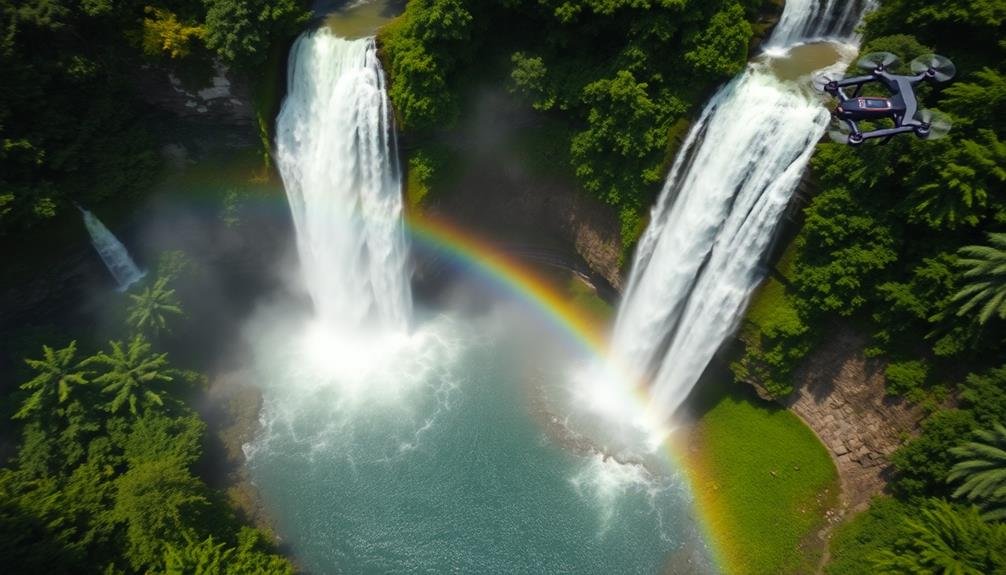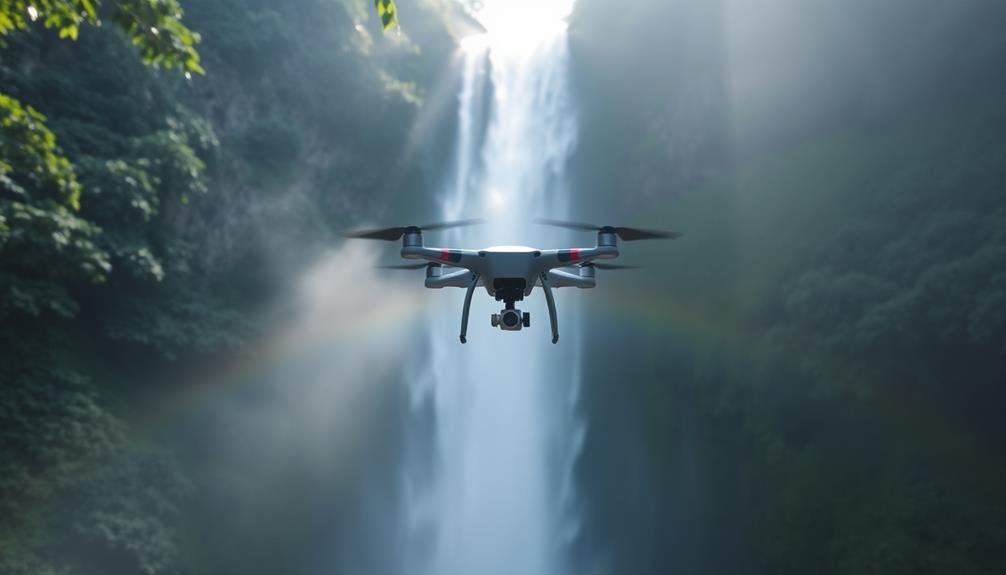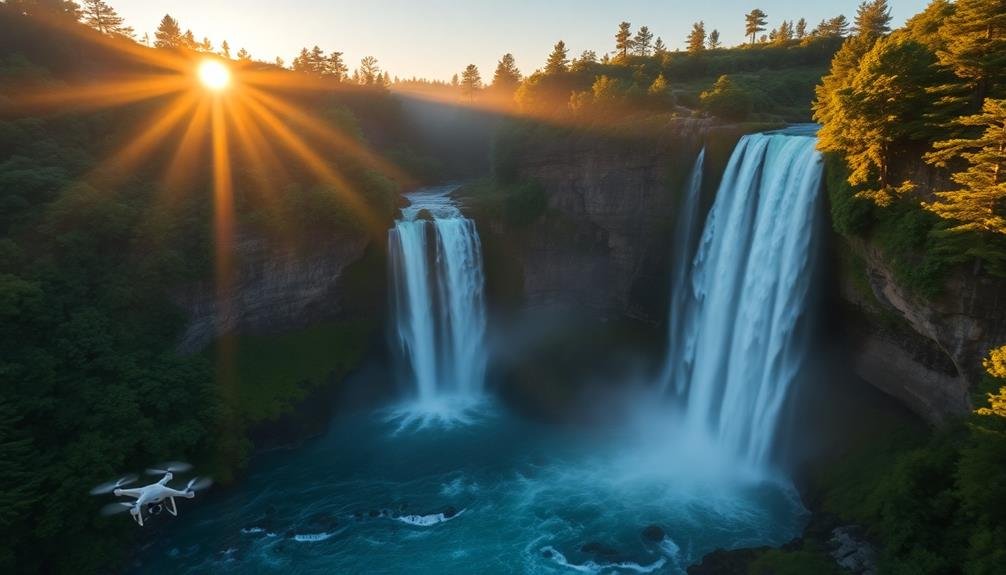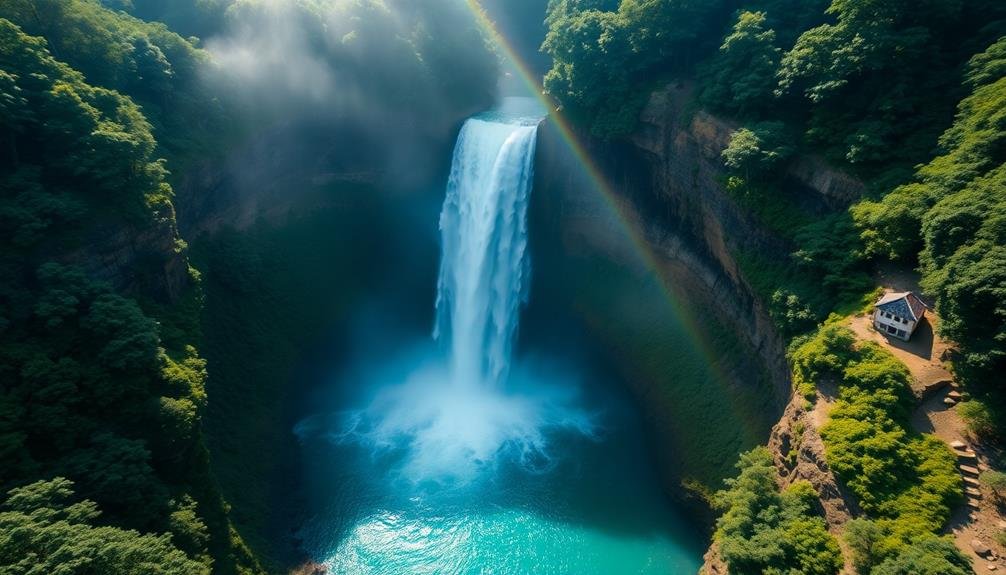To capture stunning waterfall shots with your drone, start by scouting the perfect location, considering accessibility and lighting conditions. Master your drone's flight controls, especially hovering and panning, for smooth footage. Optimize your camera settings, using RAW format and adjusting shutter speed for desired water effects. Time your shot perfectly, taking advantage of golden hours or overcast days for ideal lighting. Finally, enhance your images with post-processing techniques to bring out the best in your footage. By following these tips, you'll be well on your way to creating breathtaking aerial waterfall photography. The journey to mastering this art form is just beginning.
Scout the Perfect Location

Binoculars in hand, your quest for the perfect waterfall begins long before the drone takes flight. Research local waterfalls, considering factors like accessibility, height, and flow rate. Use topographic maps and satellite imagery to identify potential locations, paying attention to surrounding terrain and vegetation.
Once you've narrowed down your options, visit the sites in person. Observe the waterfall from different angles, noting the sun's position throughout the day. This will help you determine the best time for lighting and to avoid harsh shadows. Check for any obstacles that might interfere with your drone's flight path or signal.
Consider the waterfall's surroundings. Look for interesting rock formations, lush greenery, or colorful foliage that could add depth to your composition. Assess the area for potential take-off and landing spots, ensuring they're stable and clear of obstructions.
Don't forget to check local regulations regarding drone usage. Some areas may require permits or have restrictions on flying near waterfalls.
Master Drone Flight Controls

With your location scouted, it's time to focus on your drone piloting skills. Mastering flight controls is vital for capturing breathtaking waterfall shots. Start by practicing basic maneuvers in an open area, away from obstacles.
Learn to hover steadily, as this skill is essential for framing your shots perfectly. Practice smooth ascents and descents to capture the full height of the waterfall.
Next, work on your yaw control. This allows you to pan horizontally, following the flow of water or revealing the surrounding landscape. Master your pitch and roll to move forward, backward, and sideways with precision. These movements are key for dynamic shots that showcase the waterfall's power and beauty.
Experiment with different flight modes. Cinematic mode slows down your drone's movements, resulting in smoother footage. Sport mode, on the other hand, allows for quicker maneuvers to capture fast-moving water.
Learn to use intelligent flight modes like Point of Interest or Orbit for stunning circular shots around the waterfall.
Optimize Camera Settings

Maximizing your drone's camera settings is essential for capturing stunning waterfall shots. Start by selecting the highest image quality your drone's camera offers, typically RAW format. This preserves more detail and gives you greater flexibility in post-processing.
Set your shutter speed based on the effect you want to achieve. For a silky, smooth water effect, use a slower shutter speed (1/30 to 1 second). To freeze the water's motion, opt for faster speeds (1/500 or higher). Adjust your ISO to the lowest possible setting to minimize noise, typically 100 or 200.
For exposure, use aperture priority mode and set your f-stop between f/8 and f/11 for peak sharpness. Enable your drone's built-in ND filters or attach external ones to control light in bright conditions, allowing for longer exposures.
Use Auto White Balance for consistency, but consider adjusting it manually if the scene has strong color casts. Enable your drone's histogram to guarantee proper exposure and avoid blown-out highlights or crushed shadows.
Lastly, shoot in burst mode to increase your chances of capturing the perfect moment, especially when dealing with unpredictable water patterns and changing light conditions.
Time Your Shot Perfectly

When should you release the shutter for that perfect waterfall shot? Timing is essential when capturing waterfalls with your drone. First, take into account the water's flow rate. For powerful, high-volume falls, you'll want to shoot during peak flow to capture the waterfall's full majesty.
However, gentler cascades might benefit from a slightly reduced flow, allowing you to highlight intricate patterns in the water.
Next, pay attention to lighting conditions. The golden hours just after sunrise or before sunset often provide warm, soft light that enhances the waterfall's beauty.
Overcast days can also work well, offering even lighting and reducing harsh shadows. If you're after a more dramatic shot, try timing your capture when sunlight directly illuminates the falling water, creating a sparkling effect.
Don't forget to take into account seasonal changes. Autumn foliage can add stunning colors to your composition, while winter ice formations create unique textures.
Spring often brings increased water flow, while summer may offer lush surrounding vegetation.
Lastly, be patient and take multiple shots. Water movement is unpredictable, so capturing that perfect moment of spray or mist might require several attempts.
With practice, you'll develop an instinct for timing your shots to perfection.
Enhance With Post-Processing Techniques

Post-processing can take your drone waterfall shots from good to breathtaking. Once you've captured your raw footage, it's time to enhance it using digital editing tools.
Start by adjusting the exposure and contrast to bring out the details in both the bright water and shadowy areas. You'll want to fine-tune the highlights and shadows to create a balanced, dynamic image.
Next, focus on color correction. Boost the vibrancy of the surrounding landscape while keeping the water's natural hues. Consider using selective color adjustments to make specific elements pop, like the lush greens of nearby foliage.
Don't shy away from using filters. A graduated filter can help balance the sky with the foreground, while a radial filter can draw attention to the waterfall itself.
Experiment with sharpening techniques to accentuate the texture of the falling water and surrounding rocks.
Frequently Asked Questions
Are There Legal Restrictions for Flying Drones Near Waterfalls?
Yes, you'll often face legal restrictions when flying drones near waterfalls. Check local regulations, as many parks and natural areas prohibit drone use. Always respect no-fly zones, obtain necessary permits, and prioritize safety and environmental protection.
How Do You Protect Your Drone From Water Damage?
To protect your drone from water damage, you'll want to use waterproof cases, apply hydrophobic coatings, and avoid flying in heavy rain. Don't forget to install propeller guards and always keep a safe distance from water sources.
What's the Ideal Drone Battery Life for Waterfall Photography Sessions?
You'll want at least 30 minutes of battery life for waterfall photography sessions. It's ideal to have extra batteries on hand. This gives you ample time to scout locations, set up shots, and capture multiple angles.
Can You Use ND Filters on Drone Cameras for Waterfall Shots?
Yes, you can use ND filters on drone cameras for waterfall shots. They'll help you achieve longer exposures, creating that smooth, silky water effect. You'll need to adjust your settings accordingly and practice to get the best results.
How Do You Handle Strong Winds When Photographing Waterfalls With Drones?
When facing strong winds, you'll need to be extra cautious. Keep your drone in sport mode for better control, stay low to avoid gusts, and use shorter exposure times. Don't forget to check wind forecasts beforehand.
In Summary
You're now equipped to capture breathtaking waterfall shots with your drone. Remember to scout locations, hone your flight skills, and dial in those camera settings. Timing is essential, so wait for the perfect moment. Don't forget the power of post-processing to elevate your images. With practice, you'll create stunning aerial waterfall photos that'll leave viewers in awe. So get out there, fly safely, and let your creativity soar above cascading waters!

As educators and advocates for responsible drone use, we’re committed to sharing our knowledge and expertise with aspiring aerial photographers.




Leave a Reply